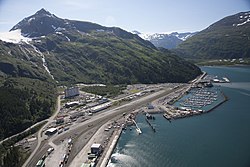
Back ويتير Arabic ويتير () ARZ ویتیر، آلاسکا AZB Уітыер (Аляска) BE Уитиър (Аляска) Bulgarian Whittier (Aljaska) BS Whittier (Alaska) Catalan Виттиер (Аляска) CE Whittier (lungsod sa Tinipong Bansa, Alaska) CEB وایتێر، ئالاسکا CKB
Whittier, Alaska | |
|---|---|
 Whittier in July 2006 | |
| Coordinates: 60°46′27″N 148°40′40″W / 60.77417°N 148.67778°W | |
| Country | United States |
| State | Alaska |
| Census Area | Chugach |
| Incorporated | July 15, 1969[1] |
| Government | |
| • Type | Council–manager |
| Area | |
| • Total | 19.64 sq mi (50.86 km2) |
| • Land | 12.25 sq mi (31.73 km2) |
| • Water | 7.39 sq mi (19.13 km2) |
| Elevation | 43 ft (13 m) |
| Population | |
| • Total | 272 |
| • Density | 22.20/sq mi (8.57/km2) |
| Time zone | UTC−09:00 (Alaska (AKST)) |
| • Summer (DST) | UTC−08:00 (AKDT) |
| ZIP Code | 99693 |
| Area code | 907 |
| FIPS code | 02-84510 |
| GNIS feature ID | 1415757 |
| Website | www |
Whittier is a small town in Alaska on the Kenai Peninsula. Whittier has 272 people always living in it.[3] The Whittier Glacier near Whittier was named for the American poet John Greenleaf Whittier in the year 1915.
During World War II the United States Army built a port and railroad near the glacier and named the port Whittier. The two big buildings that are very easy to notice in Whittier were built after World War II. The Hodge Building (now called Begich Towers) was built for housing soldiers and the Buckner Building, finish being built in 1953, was called the "city under one roof". It was once the biggest building in Alaska. The Begich Building is now a condominium (or houst that has many rooms that people live in), and almost all of the people that live in Whittier's live here.
The town was badly damaged by tsunamis (or very big waves) started by the 1964 Good Friday Earthquake; thirteen people died because of the waves that were 13 m (43 ft) tall.[4]
Whittier is a popular port for cruise ships, because people can go to Anchorage and the inside of Alaska by both car and train. Whittier is also popular with visitors and fishermen.
Whittier is the wettest city in Alaska and the United States. The city receives at least 198 inches (5,000 mm) of rain a year.[5]
- ↑ 1996 Alaska Municipal Officials Directory. Juneau: Alaska Municipal League/Alaska Department of Community and Regional Affairs. January 1996. p. 161.
- ↑ "2020 U.S. Gazetteer Files". United States Census Bureau. Archived from the original on October 28, 2021. Retrieved October 29, 2021.
- ↑ 3.0 3.1 "Whittier city, Alaska". United States Census Bureau. Retrieved September 7, 2023.
- ↑ "Surge Wave Produced By 1964 Alaska Earthquake". March 28, 1964 Prince William Sound USA earthquake and tsunami. National Oceanic and Atmospheric Administration. Archived from the original on 3 August 2016. Retrieved 6 June 2016.
- ↑ "Archived copy" (PDF). Archived from the original (PDF) on 2017-10-25. Retrieved 2017-10-21.
{{cite web}}: CS1 maint: archived copy as title (link)
